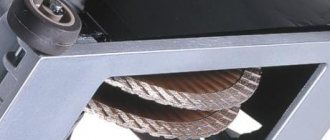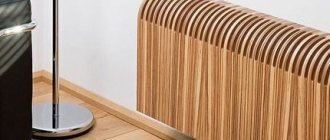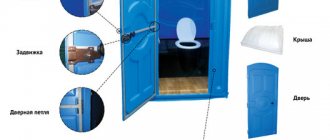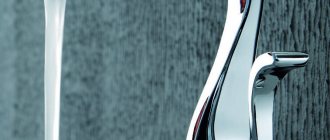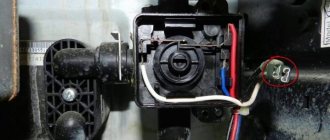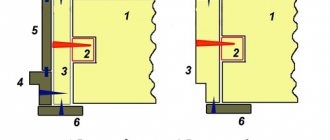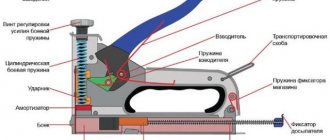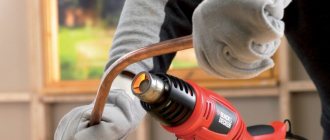Types of building levels and their main qualities
There are a large number of levels on sale that can be used during repair work. They are distinguished mainly by their operating principle and design features. These tools are classified as follows:
- Standard bubble. This is the most budget option, which is ideal for household needs. It has good measurement accuracy. The design of the device contains several ampoules with bubbles containing air. When you apply the tool to the surface, it displays in which direction you need to correct the slope. The measurement error at this level is 0.5-1 mm.
- Magnetic. This design is small in size and is suitable when working with rolled metal, for example, when constructing frames from profiles or lathing. This tool is held on vertical surfaces using the provided magnets. This is very convenient because if you need to make a recording, you can release the level without worrying about it falling.
- Electronic. The design of this option contains several bubble chambers at once, and there is also an electronic display on the front panel that indicates the error. Additionally, the design provides a sound indication, which is triggered when the ideal level is determined.
- Hydraulic level. This device is used less often and often only in cases where the objects that need to be placed in the same plane are located at some distance from each other. The device operates on the principle of communicating vessels. Typically, the device is used when pouring concrete screed.
- Laser. This is an industrial device that people try to use to measure slopes when it is necessary to do a lot of work quickly. The measurement error of the claimed device is 0.1 mm, so it can be considered the most accurate level. As a result, it is considered the most profitable purchase, but does not justify itself if it is needed for work only once. A laser level can be used to make marks at measuring distances of tens of meters.
Checking the building level for repair work Source levevg.ru
Pipe levels
These devices are suitable for a limited number of tasks. They are a suitable option for laying gas, water and sewer pipes, as well as round profiles and beams.
Design Features
These models are a type of bubble devices. They are equipped with several ampoules of liquid with an air bubble, which indicates a deviation from the required direction. Their characteristic feature is the V-shaped body and the presence of magnets.
In addition, some pipe levels are equipped with a detachable, replaceable clamp to fit the pipe diameter.
Advantages and disadvantages of pipe levels
Their advantages include the following positive qualities:
- The special design of the tools allows for easy fixation on rounded surfaces, thereby avoiding accidental slipping.
- The magnets available at the pipe levels allow you to attach the device to pipes or supports made of metal.
- They are convenient to store due to the ability to fold sections.
- They are light in weight.
In addition, they have the following disadvantages:
- Their dimensions do not exceed 40 cm.
- Limited scope.
- Compared to bubble levels, they are much more expensive.
- They display the slope of one specific pipe, without allowing you to find out the overall slope.
What factors to pay attention to when choosing a level
When choosing a building level, you need to analyze several significant factors so that the tool does not turn out to be a useless purchase. So, to choose a measuring device, you need to consider:
- Device type. For example, to perform a single repair at home, a standard bubble level is sufficient; for convenience, you can also use an electronic one, which will notify you at the right time that the correct result has been achieved. When constructing a metal frame, it is better to give preference to a magnetic device, but in the case of constructing a foundation and building a house, you should acquire a laser device.
- Length. Here everything also depends on what needs the device will be used for. For example, a 50-60 cm level will be enough to hang cabinets and correctly install any other furniture. A longer option will be required for brick or stone masonry, when it is necessary to control each laid row.
- Placement of measuring lines. Usually on capsules with bubbles, all the risks are depicted on the outside. This option is not very convenient, since such markings can quickly be erased. If it is located from the inside, then it will last many times longer.
- Workmanship. Each flask that is present at the construction level must be perfectly transparent. In addition, it is important that the housing structure is durable, since the instrument will fall repeatedly during operation. Moreover, you need to look at the reliability of fixing the bubble containers. If the design of the level does not seem reliable in appearance, then it is better to refuse such a purchase.
In general, when choosing a building level, you should give preference to trusted manufacturers, and in order not to get confused by them, we suggest that you familiarize yourself with the next section.
Construction level of short length Source nazya.com
Laser levels
These devices are also considered professional tools. Their operating principle is to create horizontal, vertical and inclined planes at a distance of several tens of meters from the location of the level itself. These measuring instruments are excellent for marking when leveling walls and ceilings, as well as installing suspended ceiling structures or those made of plasterboard, constructing interior partitions, covering surfaces with ceramic tiles and a number of other tasks.
Laser levels come in 3 main varieties - point, linear and rotary, which are designed to create points, straight lines and planes. Some models are capable of self-leveling in the range of 2-4°.
Design Features
There is an LED inside the housing that generates the light flux for the laser. In a device of the linear variety, light passes through perpendicular prisms and as a result, 2 mutually perpendicular straight lines appear. In rotational models, it is focused to a point when passing through the lens, and a straight line appears due to the rotation of the light source around its own axis. Self-leveling levels are equipped with a pendulum with a tip-weight made of copper, which freezes in a magnetic field induced by vortex flows, allowing the device to perform leveling. An ordinary laser model has a small built-in bubble level, through which you need to level the tool before using it.
Advantages and disadvantages of laser levels
Measuring instruments of this type have many positive qualities:
- They are easy to use.
- They have a wide range of applications.
- With their help, it is possible to save a significant amount of time, which usually has to be spent when marking and during other preparatory activities.
- The devices are convenient to store and transport.
- They manage to cover large areas.
Their disadvantages are as follows:
- High cost, which is fully justified due to many significant advantages when used.
- Not all laser levels come with a tripod and a case for storage and transportation. For this reason, costs may increase further.
Taking into account all of the above, laser levels are a useful acquisition, but due to their cost, they are not the optimal and justified option for simple measurements that are needed at home.
Rating of the best building levels
Conventionally, all level designs can be divided into several classifications, each of which has several options for measuring devices.
Impact devices
Such designs are considered quite convenient, have an original body design and can withstand moderate mechanical damage. Let's look at the best building levels in this class.
Armero A133/060
Construction level with good quality of the body. The device receives a cast base with a fairly wide platform. This level withstands impacts and damage well. Despite this, the calibration inevitably gets lost, but it can be quickly adjusted by first loosening the bulb mount. The length of this level is only 60 cm, weight is slightly more than 500 grams. It is important to take into account that the building level quickly loses its attractive appearance.
Advantages:
- the ability to replace and adjust the flask with a bubble;
- presence of a mirror eye;
- nice design;
- high strength.
One of the disadvantages is the short-lived coating, but the owner can always repaint the device in any color without disrupting the working functions of the level.
Impact type construction level Source 7745.by
MATRIX 34911
The body of this model consists of metal; the instrument itself has good surface qualities, plus it has sufficient strength properties. There are three ampoules in the body, responsible for horizontal, vertical and 45-degree slope. All of them have increased accuracy.
This option does not have the possibility of adjustment and correct settings, and there is also no mirror eye.
Advantages:
- high hull strength;
- simplicity of operation;
- presence of a ruler on the supporting surface;
- the presence of an additional bulb with a slope of 45 degrees.
Among the minuses, it should be noted that the design does not have adjustment screws; therefore, after damage to the level, it can go astray and adjusting it will be problematic.
Construction level of the MATRIX 34911 model Source ozybase.ru
Spirit levels
Simplicity, accessibility, and versatility distinguish water levels from all others. Its design is simple: a flask (or 3) is placed in an aluminum or polystyrene body, which is partially filled with alcohol or other liquid. As a result, the air bubble shows horizontal-vertical.
Length from 300 mm. The larger the production, the longer it is needed. One of the types of spirit levels is magnetic, which allows you to work most effectively with metal structures.
Before you buy a water level, you need to know its advantages and disadvantages. The significant advantages include:
- Increased strength. Since some models have a cast body and special stiffeners.
- Suitable for any construction and installation work, regardless of the degree of complexity.
- Ideal for apartment renovation, even a beginner without qualifications can work with it.
- Low cost.
Among the disadvantages are:
- Not suitable for large-scale construction projects as its measurement accuracy is insufficient for this purpose.
- When targeting, you need to pay attention to the behavior of the bubble, correctly understand, and also interpret deviations.
- Do not throw it carelessly, as it can easily be damaged if dropped.
Features of storage of building levels
All measuring instruments, including levels, require certain storage conditions. The thing is that these devices are most susceptible to various kinds of negative influences. Here are some simple recommendations:
- After working in dusty rooms or getting drops of cement mortar or putty on the body of the device, it is necessary to clean off the dirt, as it can make the structure heavier and, when measured, will show the result with an error.
- Be sure to avoid impacts, damage and other mechanical damage. It is strictly forbidden to try to adjust the level bubbles by using physical force.
- If the level contains ampoules with bubbles, then it is recommended to store such a device strictly horizontally. If the meter belongs to the hydraulic class, then before storage it must be completely freed from water and all components must be dried.
Each manufacturer recommends storing the levels in a protective case if it comes with the device.
Shooting off beacons using a laser level Source amicableconcerns.com
Electronic levels
These devices are professional, providing the opportunity to carry out high-precision work of increased complexity.
Design Features
Electronic levels have the same appearance as ordinary bubble instruments. They also have several bulbs for measuring vertical and horizontal planes.
Their characteristic feature is the presence of a protractor and a digital screen, on which the deviation value is displayed in degrees, percentage or millimeters according to personal preference. In addition, electronic levels have various useful functions. These include the ability to record measured slopes, as well as play an audible signal when the 0 or 90° mark is reached.
Advantages and disadvantages of electronic levels
The first include a number of the following qualities:
- High measurement accuracy.
- Easy to use, does not require special knowledge.
- Possibility of recording measured slopes.
- Notification via sound.
Their disadvantages are as follows:
- They need periodic calibration.
- These levels require careful handling.
- Their cost is an order of magnitude higher than other types of devices.
What type of level is best to buy?
Laser level
There are several types of construction levels:
- manual;
- laser
The first category includes a bubble instrument - a spirit level. Its design includes a body and flasks with liquid and a bubble fixed inside. The liquid used is industrial alcohol, which resists sub-zero temperatures.
Sometimes fluorescent substances are added to the liquid - this helps to use the device in poor lighting conditions. To determine the evenness of an object, a level is applied to one of its planes. In this case, the bubble should be located strictly in the center of the flask.
Laser tools work differently, they are more accurate and modern. There are static (linear and point) as well as rotational models. The first type involves the radiation of a line relative to which the evenness of the surface is adjusted.
Point levels display several points in different projections, and rotational models are designed to draw several lines by rotating the laser wheel.
To achieve more accurate indicators, linear laser levels are purchased for the home. For constant use of a level when working on sites, it is better to purchase a point or rotational construction level.
Device
A rigid monolithic, most often rectangular body with a milled bottom edge is made of light and durable materials (aluminum, polystyrene, plastic, wood) with an anti-corrosion coating. Depending on the required accuracy, a certain number of transparent sealed glass flasks (level eyes) with an air bubble floating in a colored alcohol-containing liquid are securely fixed in the body:
- one bulb - only for the horizontal guide (180 degrees);
- two - for horizontal (180 degrees) and vertical guides (90 degrees);
- three - for more complex work, with an additional third camera that controls the measurement of the angle of inclination (rigidly fixed at 45 degrees, or rotating - for measuring any angle of the controlled surface).
In order to minimize errors in angular vision, limiting lines—risks—are applied to the surface of the measuring flasks. Eyes for checking the position of surfaces of the vertical plane and the angle of inclination have built-in mirror reflectors for simultaneous monitoring of the position of bubbles.
Plastic plugs at the ends of the level protect the structure in case of accidental falls.
Some manufacturers of levels also provide additional conveniences: for example, a built-in magnifying lens for more comfortable control of the bubble, magnetic systems or fluorescent liquid flasks for the ability to continue work even in the dark.
The principle of operation of a bubble building level is simple: measuring and adjusting surfaces relative to the horizontal and vertical planes occurs by moving the bubble inside a certain eye of the level. The result of a correct setting will be that the bubble is located exactly in the middle between the measuring marks of the flask.
180 degree method
You can check the accuracy of the level in the simplest way, called the 180 degree method:
- It is necessary to place the building level tightly, without gaps, on a flat horizontal surface and remember the position of the bubble relative to the marks.
- In the horizontal plane, turn the level 180 degrees and place it clearly on the same area.
- At a qualitative and accurate level, the position of the bubble should remain the same.
In the same way, you can check the accuracy of the vertical readings.
